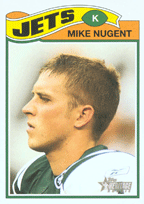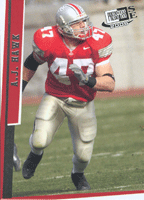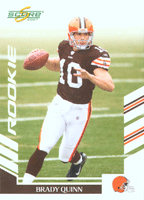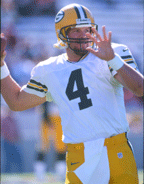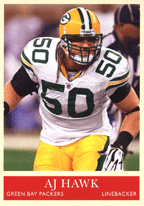| A.J. Hawk — Biography | |||||
| bio | facts | what they say | my say | ||
Ask 100 fans to describe the ideal NFL linebacker and you’re likely to get 100 different answers. Ask a Green Bay fan and the answer will almost certainly be A.J. Hawk. He moves like a safety, thinks like a coach and hits like a truck. A workout monster who loves practice as much as games, he brought a load of talent and a tough new attitude to a Packers team in transition—helping them transform into a Super Bowl team just a few years later. AJ is a big reason why Green Bay is calling itself “Title Town” again. This is his story…
| |
GROWING UP
Aaron James Hawk was born on January 6, 1984 in Kettering, Ohio. (Click here for a complete listing of today's sports birthdays.) The Hawks lived in Centrevillle, a suburb of Dayton. A.J.'s parents, Judy and Keith, were fans of auto racing—and A.J. Foyt in particular. The nickname A.J. was a natural for their third son.
Like his older brothers, Matt and Ryan, A.J. was big, fast, tough and strong-armed. All three Hawk boys played football. Ryan was a talented quarterback in high school who would later lead Ohio University. Eventually, he moved on to the Arena League Football.
A.J. and his brothers followed Ohio State as boys and idolized the school's great linebackers. Columbus was just an hour away, so the Hawks got to see the Buckeyes play on several occasions.
A.J.’s talent as an athlete was evident from the age of three. His parents knew it and so did his brothers. Matt and Ryan pounded A.J. mercilessly throughout his childhood, but this treatment only served humble their little brother and toughen him up. A.J. played football in the fall, basketball in the winter and baseball in the spring and summer. Football, however, was the family game and his favorite sport.
As his sons began to draw attention on the football field, Keith offered advice that A.J. remembers to this day. No matter what you hear or read, the elder Hawk said, keep your head level. Never buy into the praise and never believe the criticism. A.J. and his brothers kept those words of wisdom in mind as each moved through youth football and onto Centerville High School.
A.J. enrolled at Centerville in 1997 and made the varsity as a freshman. Over the next four years, he would play middle linebacker on defense and running back on offense. He was also the punter for the Elks and became the team's kicker after the graduation of Mike Nugent, who would go on to star at Ohio State.
By the end of his sophomore season, A.J. was clearly the best player on Centerville. Even Ryan ranked behind him, and he was setting school passing records. Ever modest, A.J. did not like the attention accorded him as the varsity stud, He declined to wear a letterman’s jacket and insisted that his parents not cheer for him from the sidelines. A.J. was not a rah-rah guy. He led in a reserved way, either by quietly talking to his teammates or setting examples in practice and during games. A.J. also led in the weight room. His warrior-like workouts were legendary.
The Elks won their league championship in 1998 and 1999 (under coach Bob Gregg) and again in 2000 (under Ron Ullery). But it was linebackers coach Luke Fickell who had the greatest impact on A.J. Fickell had played at Ohio State and taught A.J. the tricks of the trade, including how to use his hands against blockers. That tip made a tremendous difference in his game. A.J. was named All-State as a junior and as a senior and established school records with 30 tackles in a game and 583 for his varsity career.
A knee injury hampered A.J. somewhat his senior year, keeping him out of the headlines and off the top of the recruiting charts. Ohio State knew about the senior star, however, and offered him a scholarship. He accepted. It was the 25th of 26 spots the Buckeyes had open for scholarships.
ON THE RISE
A.J. was an unheralded member of a heralded recruiting class that included Bobby Carpenter, Mike D’Andrea and Stan White. He had the lowest profile of any of the linebackers in the incoming class—. In fact, if things didn’t pan out, the Buckeyes planned to turn him into a back-up fullback. As soon as practice began, A.J. began making an impression. He was a savage hitter and a smart player. Slowly but surely he moved up the depth charts as opening day drew near.
A.J. started the 2002 campaign as a reserve but saw significant playing time as the season progressed. He contributed with 26 tackles and a pair of interceptions, running one back for a TD (in just his second college game). A.J. got his one and only start of the season against Penn State and picked off a pass on the Nittany Lions’ first possession.
With A.J. part of a talented mix of youth and experience for Ohio State, it was a quite a year in Columbus. Indeed, the Buckeyes became the first team ever to run the table at 14–0. A.J. made a key tackle in the 14–9 win over Michigan that sent Ohio State to the BCS Championship Game in the Fiesta Bowl. In a thrilling overtime contest against Miami, the Buckeyes were crowned 2002 national champions.
A.J. was promoted to the starting squad in his sophomore season and immediately showed All-America potential. In a close, low-scoring game against San Diego State, he sacked the quarterback twice and dropped three other ball-carriers behind the line of scrimmage. A week later, he was all over the field against NC State in a dramatic triple-overtime victory.
![]()

Game after game, A.J. was in on almost every tackle. He raised his level of play in the biggest Big Ten conference battles. Along with Carpenter and Anthony Schlegel, he gave the Buckeyes a formidable linebacking trio.
A.J. topped the Buckeyes in tackles and was named All-Big Ten at season’s end. In the Fiesta Bowl against eighth-ranked Kansas State, he had 10 stops. The Buckeyes won 35-28, and A.J. was named the game’s defensive MVP.
A.J. truly came into his own as a junior in 2004. He led the nation with 141 tackles. In three October games alone, he had 49 tackles. Against Michigan State in November, A.J. made a twisting midair interception to preserve an Ohio State victory. Later that month, he recorded 11 tackles as the Buckeyes upended #7 Michigan, 37-21.
The Buckeyes had a good team, but they lacked the swagger of a great one. In the season’s final game, they were paired with Oklahoma in the Alamo Bowl and won 33-7. A.J. posted five tackles in the game.
After the victory over the Sooners, Ohio State fans kept their fingers crossed that A.J. Hawk would return for his senior year. Had he declared for the NFL draft, he would have been a surefire first-rounder. But A.J. was having too much fun in college. He wanted his degree, and he could not imagine leaving his teammates high and dry. A.J. ended any conjecture by announcing he would stay in Columbus for another year.
The 2005 season looked to be a promising one for A.J. and the Buckeyes. He had begun dating Laura Quinn, whose brother, Brady, played for Notre Dame. Laura and A.J. would later marry. As for Ohio State, the receiving duo of Santonio Holmes and Ted Ginn Jr. gave the team some real offensive firepower.
A.J. cemented his reputation as a big-game player in Ohio State’s early-season confrontation with Vince Young and the Texas Longhorns. In the first half, he stopped drives dead with an interception, a fumble recovery and a sack. In the fourth quarter, he nailed Young to force a fumble. Still, Texas rebounded to win 25-22, a loss that A.J. calls the low point of his college career. It was a homefield loss that practically guaranteed that the Buckeyes would not be part of the BCS championship picture.
A.J. turned the disappointment of the Texas loss into motivation. Against Michigan State game, he corralled Spartan runners 19 times in a 35-24 victory. Against Northwestern, he forced a fumble and returned a blocked punt for a touchdown in a 48–7 wipeout.
A.J.’s final college game came against Notre Dame in the Fiesta Bowl. He sacked Quinn twice (creating a fun atmosphere for the next family get-together) and was named defensive MVP in a 34-20 win.
A.J. was voted a consensus All-American for the second straight season and earned the Lombardi Award, given to the nation’s top linebacker or lineman. He finished his college career with 394 tackles and 15.5 sacks.
MAKING HIS MARK
A.J. was a no-brainer first-round pick in the NFL draft. He was invited by the league to come to New York on draft day but politely declined. A.J. preferred to share the day with his friends and family back in Ohio. He wasn’t sure who would take him, but he secretly hoped it would be Green Bay. The Packers impressed him with their winning focus, and Green Bay reminded him of Columbus, a football-obsessed city with a small-town feel.
The Packers wanted A.J. and believed they could land him with the fifth pick. They considered trading up—and were offered some interesting deals to trade down—but they stayed put and got their man. He was the first linebacker taken in a draft packed with excellent linebackers.
The Green Bay defense was a perfect for fit A.J. and vice-versa. The Packers liked their linebackers to create havoc with ultra-aggressive play. A.J. would be teamed with Nick Barnett and Brady Poppinga in the team's 4-3 set.
With veteran quarterback Brett Favre surrounded by an unproven offense, the Green Bay defense would be counted on for takeaways and clutch stops to deliver victories. In his first game, against the Chicago Bears, A.J. nailed Thomas Jones in the backfield on a screen pass and harassed Rex Grossman into a couple of bad passes. A week later, against the New Orleans Saints, he broke up a sure scoring pass to tight end Nate Lawrie.
A.J.’s first sack came the following week, against the Detroit Lions. It demonstrated just how quickly he was learning the NFL game. A.J. noticed that his pass-coverage assignment, tight end Dan Campbell, was staying in as a blocker. Without hesitation, he exploded through a hole in the protection and buried Jon Kitna. It was the kind of instinctive play that marked A.J.’s early career.
A.J. had a great game against the Miami Dolphins in late October, registering 16 tackles, including a sack, in Green Bay’s 34-24 victory. A.J. was named Rookie of the Week for his effort. Three weeks later, he won the award again as he made 13 tackles and a forced fumble against the Vikings. He sacked quarterback Brad Johnson once and teamed with Nick Bennett for another sack. Minnesota had already seen enough of A.J.—in Green Bay’s first meeting with the Vikings, he amassed 17 tackles.
A.J. concluded his rookie season with his first two NFL interceptions in December games against the San Francisco 49ers and Bears. The Packers won both games but finished out of the playoff picture at 8–8. When the season ended, A.J. was the team’s leader with 155 tackles. His 112 solo stops as a rookie ranked third in the league behind Demeco Ryans and Lance Briggs.
As the 2007 season approached, the talk in Green Bay centered around Favre’s future. Would he retire, or would he stick around just to muddle through another mediocre year? Favre decided to stay, telling reporters the Packers had as much talent as the teams he led into the Super Bowl.
| |
Favre obviously saw something the experts did not, as Green Bay rolled to a 13–3 record and the NFC’s second seed in the playoffs. A.J. was a big part of the team’s resurgence. He finished second on the Packers with 155 tackles, playing his best against playoff-bound teams, including the New York Giants and San Diego Chargers.
A.J. had a monster game against the Washington Redskins in October, culminated by a diving fumble recovery on which he was knocked unconscious. Against the Dallas Cowboys, he had a season-high 14 tackles.
As the regular season drew to a close, it looked as if the Packers would be facing the Cowboys for the NFC championship. After a first-round bye, Green Bay took on Seattle on a slushy Lambeau Field. The Seahawks started strong, and Green Bay fans started to fret that the team’s inexperience was being exposed. But after two early turnovers lead to two touchdowns, the Packers turned it around and humiliated Seattle, 42–20. A.J. racked up six tackles on the day.
Meanwhile, the Giants stunned the Cowboys, setting up an unexpected matchup in the NFC Championship Game. The weather for the contest provided classic playoff conditions—frigid temperatures with a slight wind. A.J. made a great defensive play to extinguish a scoring bid before the half, and the Packers took a 10–6 lead into locker room.
The game continued to seesaw in the second half. Green Bay’s defense alternated between being jumpy and tentative, and the Giants were able to control the ball for long stretches. But the Packers held when they had to, and after 60 minutes, the game was tied 20–20. Green Bay won the overtime coin toss and started with the football. Favre, however, threw an interception, and the Giants kicked a field goal for the victory a short time later.
In the shadow of defeat, it was difficult for A.J. and his teammates to appreciate how much progress the Packers had made just two years after going 4–12. Coming within an OT field goal of a trip to the Super Bowl was a remarkable accomplishment for a young team.
The Packers got a little younger in 2008, at least at quarterback. Favre announced his retirement after the Super Bowl, leaving the door open for Aaron Rodgers, who had been waiting patiently for three seasons to get the starting nod. When Favre un-retired and arrived at training camp that August, it created a confusing situation for the team and the players. Favre was eventually shipped to the New York Jets, ending once and for all the lingering QB controversy.
The Packers played a lot of close games in ’08, but they didn't win many of them. Seven of their 10 defeats came by a touchdown or less, as Rodgers went through the typical growing pains of a first-year starter. The defense bore some responsibility for the team’s 6–10 record. With a few key plays at the right moment, Green Bay’s record could easily have been reversed. A.J. began the year as the Packers’ weakside linebacker. Just past the midway point, he moved to middle linebacker, replacing Nick Barnett, who injured his knee. A.J. started all 16 games, making 86 tackles and recording three sacks. He did not have an interception.
Things turned around quickly for Green Bay. In 2009, Rodgers started making more big plays and fewer mistake, and the 3-4 defense installed by new coordinator Dom Capers began to click. A five-game winning streak at mid-season helped Green Bay finish 11–5. A.J., now playing inside linebacker alongside Barnett, had a terrific year. In a win over the Lions, the pair combined for 20 tackles. In fact, the entire linebacking corps—including converted end Aaron Kampman and rookie sensation Clay Matthews—played well. Although limited to 14 starts, A.J. appeared in all 16 games and nearly matched his previous tackle total, with 85. He also picked off two passes and forced a fumble.
The Packers earned a trip to the playoffs, where they faced the Arizona Cardinals in the first round. Both Rodgers and Kurt Warner brought their A-games, picking the defenses apart. Warner burned the Green Bay secondary for five touchdown passes, but the Cardinals had no better luck against Rodgers. After 60 minutes, the score was tied 45–45.
The Packers won the coin toss and started with the ball in overtime. There was no reason to believe that they wouldn’t march down the field and win the game. But Rodgers was stripped of the ball as he dropped back to pass, and the fumble went right into the arms of Karlos Dansby, who ran it into the end zone.
Despite this disappointing end to the ’09 season, AJ and his teammates had reason to be optimistic heading into 2010. Their defense was playing tight, consistent football. The offense had multiple weapons. And there were no juggernaut teams in the NFC. The question was: what role would A.J. play? On most passing downs, he trotted to the sidelines and was replaced by Brandon Chillar, a coaching decision that he didn’t like. Early on, it looked as if he might only get in on half of the defensive snaps.
After a sluggish first half, the Green Bay defense threw it into another gear, and the team made a spirited playoff run. A.J. was one of the catalysts. He saw more and more playing time and ended up leading the team in tackles. The Packers won their final two games by wide margins and rolled into the playoffs as one of the hottest teams in the league.
The breakthrough performance of Matthews had a ripple effect throughout the defense. A.J. was more effective against the pass, intercepting three balls and knocking down six more in coverage. After the season, he was tabbed as an alternate for the Pro Bowl. Four packer defenders, meanwhile—Matthews, Charles Woodson, Nick Collins and Tramon Williams—were also Pro Bowl picks.
The Packers were arguably the best team in the NFC, but their 10–6 record only earned them the #6 seed in the playoffs. To reach the Super Bowl, they would have to win on the road. They did just that. First, Greeny Bay corralled Michael Vick and the Eagles in Philadelphia. Next, they throttled down Matt Ryan and the Falcons in Atlanta. In the NFC Championship Game, the Packers punished and confused Jay Cutler and the Bears. Though Chicago rallied late, the contest was never in serious peril. Green Bay won 21-14 and moved onto the Super Bowl against the Pittsburgh Steelers.
As expected, the big game featured lots of scoring, even with both defenses shutting down the running game and putting pressure on the quarterback. The Packers got a tough break at the end of the first half when Woodson was forced from the action with a collar bone injury. A.J. and his teammates responded with a gutty effort. The Green Bay secondary was particularly impressive. Pittsburgh had a chance to win on its final possession, but the Packers held on to win 31-25. Rodgers was named the game’s MVP. A.J. made two tackles. His experience and cool head proved invaluable with Woodson on the sidelines.
A.J. has established himself as a leader of one of football's most physical and hardest-hitting defenses. As he did in college, he sets the tone with his attitude and hustle. In a hardworking city like Green Bay, he has become a local hero—just the way he likes it.
A.J. THE PLAYER
A.J. is one of the best tacklers in the league. He can handle ball-carriers one-on-one, rarely needing assistance even when he does not get a clean first shot. Though known for his quick, hard-hitting style, A.J. understands his role on every play and rarely blows an assignment. He is particularly good in the red zone, where he often makes big plays to kill drives.
A.J. has great instincts when it comes to knowing where he should be on the field. While he lacks explosive speed or over-the-top athleticism, he is capable of making game-changing plays. His value to the Packers is that his 10 teammates know he will take care of business if they gamble and lose.
A.J. is not considered to be an every-down defensive player by some critics. Although able to shed blocks on rushing plays and chase down running backs from sideline to sideline, he sometimes has difficulty covering slot receivers and tight ends. This is ironic, considering he began his football life as a defensive back. Often the Packers will remove him from their nickel package on passing downs.
A.J. is a classic intangibles player. His work ethic rubs off on teammates. So does his desire to win. When the Packers need a big stop, A.J. can usually be found right in the middle of the action.
| A.J. Hawk — Biography | |||||
| bio | facts | what they say | my say | ||
© Copyright 2011 Black Book Partners, LLC. All rights reserved.
